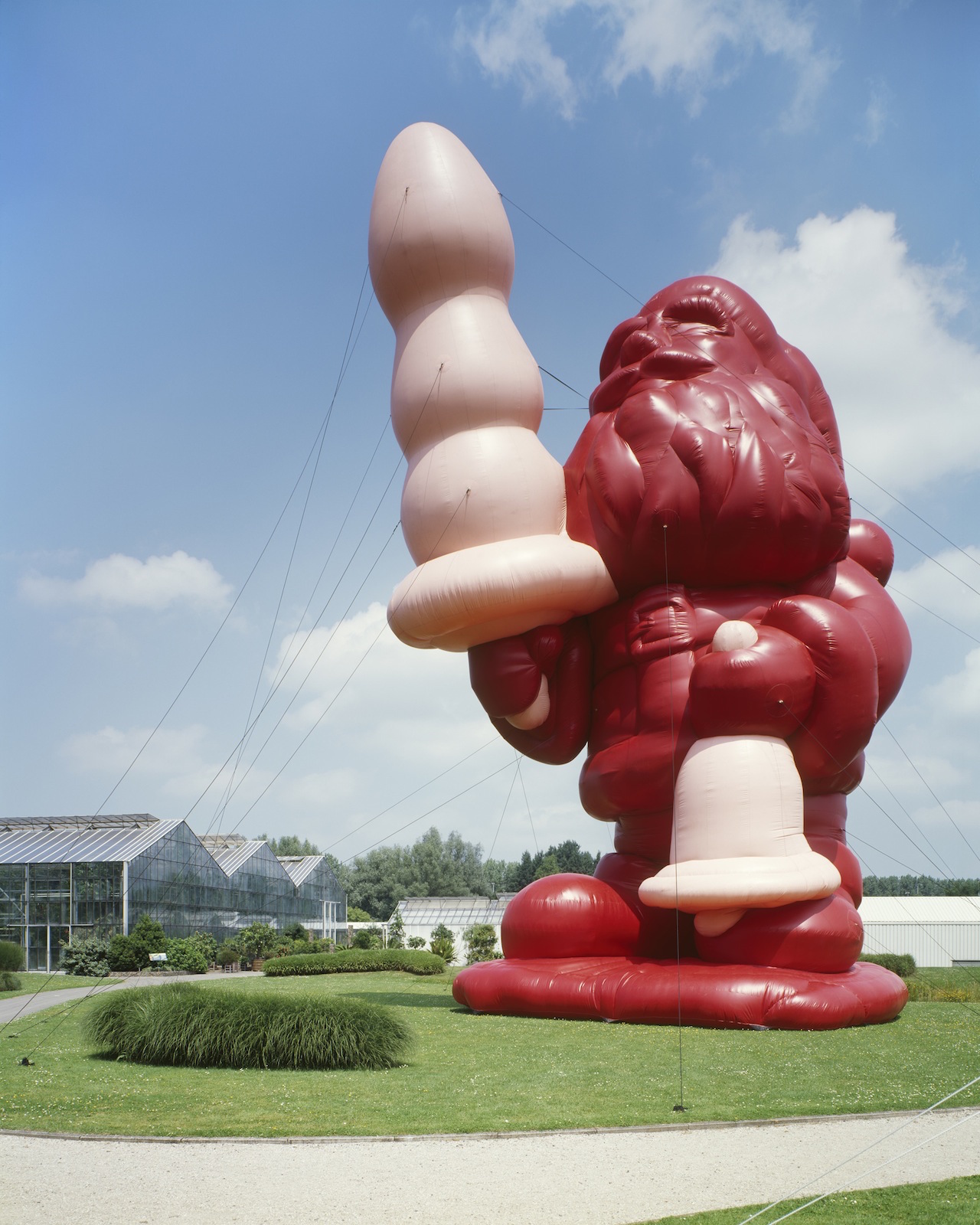
Joe Caslin, “Yes Equality” (2015) (photo by David Sexton
Art Movements is a weekly collection of news, developments, and stirrings in the art world.
Artist Joe Caslin completed a 45-foot-tall mural on the side of a remote Irish castle. The work, which depicts two women in embrace, was created to mark Ireland’s same-sex marriage referendum, which takes place today.
New York’s City Council passed a bill requiring public hearings before certain public art projects are installed. The bill was introduced by Councilman Jimmy Van Bramer following criticism of a Ohad Meromi sculpture commissioned for Long Island City’s Jackson Avenue. The bill needs to be signed by Mayor Bill de Blasio before it becomes law. De Blasio recently signed a bill that requires the Department of Cultural Affairs to analyze its art and community activities in response to the economic hardship felt by the majority of the city’s artists and arts professionals.
Abdel Majid Touil was arrested in connection to the March attack on the Bardo Museum in Tunis, Tunisia, which resulted in the deaths of 22 people.
Arts advocate Margaret Kargbo and disability activist Frank Barham were killed in a highway accident. Kargbo was documenting “Wheel 2 Live,” a project commemorating the 25th anniversary of the Americans with Disabilities Act.
Following a freedom of information request filed by Gawker’s Matt Novak, the FBI published 44 heavily redacted documents from its files on architect Buckminster Fuller.
Detained Cuban artist Tania Bruguera will stage a 100-hour reading of Hannah Arendt’s The Origins of Totalitarianism (1951) at her home in Havana.
The Bank of England will include an artist on the new £20 note. Members of the public can submit their nominations through the Bank of England’s website.
James Knowles III, the mayor of Ferguson, announced that the city will erect a permanent memorial to Michael Brown.
Film producer Valeria Richter, who has part of her left foot amputated, was initially barred from the Cannes Film Festival for not wearing high heels. Richter was one of a number of women who claimed that female guests were required to wear heels.
Max Liebermann’s “Two Riders on a Beach” (1901) will go to auction next month, making it the first work from the art hoard of Cornelius Gurlitt to go on sale. Last week, a German court approved the painting’s return to the heirs of its rightful owner.
Columbia University student Emma Sulkowicz brought her mattress to her graduation ceremony. Sulkowicz embarked on an ongoing performance entitled “Performance: Carry that Weight” after alleging that a fellow student – Paul Nungesser – raped her. University President Lee C. Bollinger turned away from Sulkowicz as she crossed the stage, refusing to shake her hand.
New York City’s Landmarks Preservation Commission decided that the interior of the Four Seasons restaurant should not be altered. The owner of the Seagram building, art collector Aby Rosen, had proposed changes to the building’s interior.
The National Council of Architectural Registration Boards (NCARB) voted to discontinue the title “intern.”
The Victoria and Albert Museum is collaborating with Imperial College and University College London to devise conservation methods for works of design made of plastic.
Danny Boyle gave a speech at the opening of Home, a new £25-million (~$38.7 million) arts centre in Manchester. Boyle, who is perhaps best known as the director of Trainspotting (1996) and Slumdog Millionaire (2009), is a patron of the venue.
Charles Le Brun’s “Everhard Jabach and His Family” (ca. 1660) went back on display at the Metropolitan Museum of Art following a ten-month conservation project.



Art Movements is a weekly collection of news, developments, and stirrings in the art world.
Artist Joe Caslin completed a 45-foot-tall mural on the side of a remote Irish castle. The work, which depicts two women in embrace, was created to mark Ireland’s same-sex marriage referendum, which takes place today.
New York’s City Council passed a bill requiring public hearings before certain public art projects are installed. The bill was introduced by Councilman Jimmy Van Bramer following criticism of a Ohad Meromi sculpture commissioned for Long Island City’s Jackson Avenue. The bill needs to be signed by Mayor Bill de Blasio before it becomes law. De Blasio recently signed a bill that requires the Department of Cultural Affairs to analyze its art and community activities in response to the economic hardship felt by the majority of the city’s artists and arts professionals.
Abdel Majid Touil was arrested in connection to the March attack on the Bardo Museum in Tunis, Tunisia, which resulted in the deaths of 22 people.
Arts advocate Margaret Kargbo and disability activist Frank Barham were killed in a highway accident. Kargbo was documenting “Wheel 2 Live,” a project commemorating the 25th anniversary of the Americans with Disabilities Act.
Following a freedom of information request filed by Gawker’s Matt Novak, the FBI published 44 heavily redacted documents from its files on architect Buckminster Fuller.
Detained Cuban artist Tania Bruguera will stage a 100-hour reading of Hannah Arendt’s The Origins of Totalitarianism (1951) at her home in Havana.
The Bank of England will include an artist on the new £20 note. Members of the public can submit their nominations through the Bank of England’s website.
James Knowles III, the mayor of Ferguson, announced that the city will erect a permanent memorial to Michael Brown.
Film producer Valeria Richter, who has part of her left foot amputated, was initially barred from the Cannes Film Festival for not wearing high heels. Richter was one of a number of women who claimed that female guests were required to wear heels.
Max Liebermann’s “Two Riders on a Beach” (1901) will go to auction next month, making it the first work from the art hoard of Cornelius Gurlitt to go on sale. Last week, a German court approved the painting’s return to the heirs of its rightful owner.
Columbia University student Emma Sulkowicz brought her mattress to her graduation ceremony. Sulkowicz embarked on an ongoing performance entitled “Performance: Carry that Weight” after alleging that a fellow student – Paul Nungesser – raped her. University President Lee C. Bollinger turned away from Sulkowicz as she crossed the stage, refusing to shake her hand.
The National Council of Architectural Registration Boards (NCARB) voted to discontinue the title “intern.”
The Victoria and Albert Museum is collaborating with Imperial College and University College London to devise conservation methods for works of design made of plastic.
Danny Boyle gave a speech at the opening of Home, a new £25-million (~$38.7 million) arts centre in Manchester. Boyle, who is perhaps best known as the director of Trainspotting (1996) and Slumdog Millionaire (2009), is a patron of the venue.
Charles Le Brun’s “Everhard Jabach and His Family” (ca. 1660) went back on display at the Metropolitan Museum of Art following a ten-month conservation project.

The Met Museum’s riggers hanging Charles Le Brun’s “Everhard Jabach (1618–1695) and His Family” (c. 1660)
New York City’s Department of Transportation unveiled the murals it commissioned for the 191st Street tunnel.
Egypt’s Ministry of Antiquities denied claims by the Egypt Heritage Task Force that the Apis Bull of Hadrian had been broken into pieces during transit.
The 2015 Biennial of the Americas will open on July 14 in Denver.
The New York Times produced a short documentary on Chris Burden’s seminal performance art piece “Shoot” (1971).
The Sir John Soane’s Museum opened up previously inaccessible rooms to the public.
Transactions
The Heritage Lottery Fund donated £9.5 million (~$14.7 million) to the British Library’s digitization of its sound archives.
The Winton Guest House, a home designed by Frank Gehry, sold for $1.5 million at auction, despite having been previously valued at $4.5 million.
Transitions

The W.A.G.E. logo (via wageforwork.com)
Diverse Works, Light Industry, Machine Project, Three Walls, and Side Street Projects became W.A.G.E. (Working Artists and the Greater Economy) certified.
Anne Pasternak was appointed director of the Brooklyn Museum.
The Whitney Museum of American Art promoted Donna De Salvo to deputy director for international initiatives and senior curator, and Scott Rothkopf to deputy director for programs and chief curator.
Michael Taylor was appointed chief curator and deputy director for art and education at the Virginia Museum of Fine Arts.
The Luminato Festival hired Anthony Sargent as its new CEO.
Vivian Li was appointed a curator of Asian art at the Worcester Art Museum.
Accolades
Amsterdam’s Rijksmuseum was named European Museum of the Year by the European Museum Forum.
Frank Gehry will receive the J. Paul Getty Medal for leadership in visual art on September 28.
Alexandre Arrechea was named artist of the year by the Farber Foundation.
The Baker Artist Awards announced their 2015 Mary Sawyers Baker Prize winners.
Paul McCarthy and Diane Keaton will be honored at the Hammer Museum’s annual gala in October.

Paul McCarthy, “Santa with Butt Plug” (2007), vinyl-coated nylon, four fans, rigging, 24.40 x 12.20 m / 80 x 40 ft, at Paul McCarthy – Air Pressure, De Uithof, City of Utrecht, Netherlands, 2009 (photo by Mark Vos © Paul McCarthy, Courtesy the artist and Hauser & Wirth)







